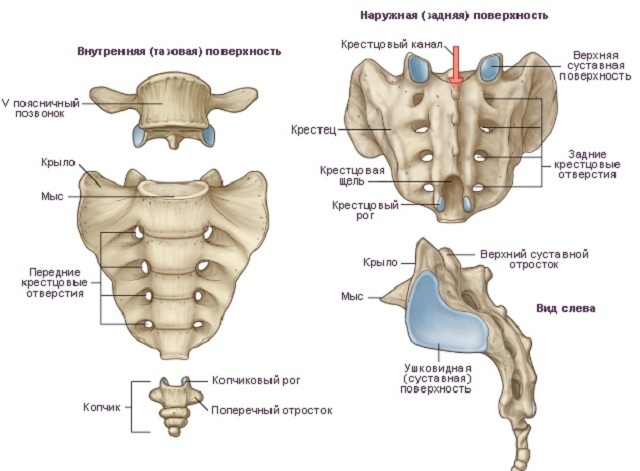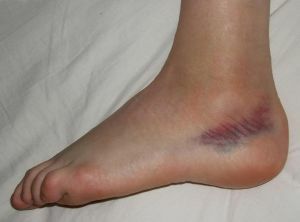 This trauma is very common in traumatology and accounts for approximately twenty percent of all injuries in the musculoskeletal system.
This trauma is very common in traumatology and accounts for approximately twenty percent of all injuries in the musculoskeletal system.
Fracture of the ankle is divided into fractures with a displacement and without displacement .Injuries in the ankle can not be recognized with the naked eye.
His symptoms are mild, and most doctors usually have to resort to an X-ray.
One of the main mistakes of the victims is self-medication.
Article Contents
- cause injury
- Classification
- fractures By Type
- damage-stock
- offset Localization
- injury Direction fracture
- Combined( complex) fractures
- Characteristic symptoms
- Symptoms closed fracture in the outer ankle without bias
- Symptoms of a fracture in the inner ankle withoutof displacement
- Signs of fracture in the ankle with a bias
- Open fracture in the ankle
- Diagnostic techniques
- Healing measures for injuriesof the kind
- First aid
- Follow-up treatment
- Surgical intervention
- Rehabilitation after trauma
- Preventive measures
- Video: Gymnastics after an ankle fracture
Causes of an injury
The causes of an ankle injury are usually divided into two categories:
- First: the fracture took place as a resultinjury. In this case, the fracture becomes the result of a sharp turn of the foot or its tucking. This is sometimes external or internal. There are also complex fractures involving the fracture of other bones or associated with a dislocation. Also, in rare cases, an ankle fracture can result from an accented stroke.
- The second: trauma, as a result of age-related changes in the body. It is widely known that calcium is worse absorbed with age, and the bones become more fragile. In older people, fractures are more common. Are not rare and fractures of the ankle. In addition, it should be noted that at an advanced age, the bones grow worse, which often entails a long period of rehabilitation after the trauma.
Of course, these reasons do not exist separately from each other and often go side by side.
Although it is established that in older people the fracture can happen almost "on the level", in a situation that does not have that.
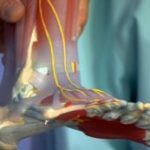 If you need information about the recovery time for ankle dislocation, then read our article. You will also learn about first aid in case of trauma and subsequent treatment. It is not difficult to determine the first signs of dislocation of the foot if you know simple rules. Learn more from our article.
If you need information about the recovery time for ankle dislocation, then read our article. You will also learn about first aid in case of trauma and subsequent treatment. It is not difficult to determine the first signs of dislocation of the foot if you know simple rules. Learn more from our article.
Classification of fractures
The classification of ankle injuries is very extensive and involves a large number of options. We select basic and most common:
By type of damage
- Open( with a bleeding wound and bone fragments);
- Closed( no breakthrough soft tissue).
By the presence of offset
- Accompanied by the offset;
- Without offset.
By localization of injury
- In the outer ankle( distal part of the tibia);
- of the inner ankle( distal part of the tibia).
In the direction of the fracture
- Pronational( turning the ankle out);
- Supination( tucking in the ankle);
- Rotational( pivoting with a turn).
Combined( complex) fractures
- With a dislocation;
- With the involvement of other bones.
The most common is a fracture of the external ankle without bias.
Symptoms
What are the symptoms for which we can diagnose a fracture in the ankle? Symptoms of injury will, inevitably, differ, depending on the variety of fracture.
Let's analyze the symptomatology, depending on the type of injury:
Symptoms of closed fracture in the external ankle without bias 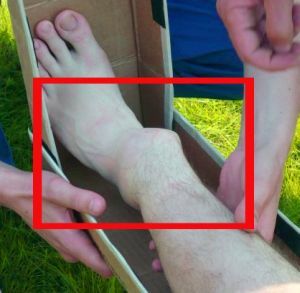
The main symptom for such a trauma is ankle swelling. Mobility is complicated. The victim, as a rule, can bend the ankle, but turning the ankle out of the way, is accompanied by a sharp pain.
Also in patients, the radiating symptom will appear: when pressing on the middle of the ankle, the pain will manifest itself at the fracture site.
There are cases when patients with a fracture in the external ankle continue to walk for some time, stepping on the aching leg, suspecting a "normal bruise".
Symptoms of fracture in the inner ankle without bias
This injury also differs from the by the presence of swelling in the ankle joint region of , however in this case, the swelling will be localized on the inner part of the ankle.
Thus, the ankle will have a smoothed out appearance, without the generally allocated bone. When moving in the ankle joint, the patient will feel a sharp pain.
There are cases when, with such a trauma, patients for a few more days advanced on a sore leg, leaning on the heel or rib of the foot.
When palpated, the pain manifests itself on the inside of the foot.
As with a fracture of the external ankle, this type of injury is difficult to diagnose without an X-ray machine.
Therefore, patients often for a long time try to treat themselves without referring to doctors, which negatively affects the rehabilitation process and its success.
Symptoms of fracture in the ankle with bias
Clinic of such an injury will be similar to the one described above, however with the symptoms will be more acute .
So the pain will be stronger and the patient will not be able to step on his foot. The swelling in the fracture site will be much more pronounced and often accompanied by a hemorrhage. Splinters of bones during movement can dig into soft tissues, causing intolerable pain.
A pain shock, sometimes accompanied by loss of consciousness, is not uncommon in this case.
Open fracture in the ankle
Trauma is accompanied by soft tissue rupture and bleeding .In the area of the ankle, there are large blood vessels, the rupture of which, the patient may lose a lot of blood, so in this case it is extremely important to quickly stop the bleeding.
In some cases, bone fragments can bulge outward, which shock the victim. The victim may experience pain and psychological shock due to blood loss, so it is especially important that there are people close to him who are ready to provide first aid.
Diagnostic Techniques
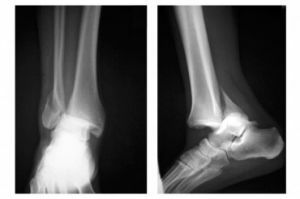
On the photo fracture of the ankle with bias on the x-ray
The doctor examines the patient's leg and is interested in the situation of injury. Clarifies the symptoms and physical mobility of the foot. In most cases, the doctor resorts to X-ray diagnostics or computed tomography.
Definition of an accurate diagnosis, with general symptoms of swelling and bruising in the ankle, is very complicated.
Thus, only an X-ray can give an accurate picture of the injury: the presence of fracture, displacement or fragments of bone tissue.
The image is taken in the side and antero-posterior version.
In the case of an external ankle injury, the following changes are noted in the picture:
- In the case of a pronation fracture of , in the picture from the rear, a barely visible fault line runs along an oblique line in the level of the interdental syndesmosis. On the side picture, the fault line is traced more clearly and has an upward direction.
- In the supine fracture , in the picture from the rear, a transverse line is seen in the ankle joint or below. On the side picture, the line is not clearly traced, runs along the top of the talus bone.
In case of a trauma in the inner ankle, shows the following changes in the image:
- In the transverse fracture , in the picture from the rear, the horizontal line of the fracture crosses the ankle base at the level of the ankle or below. On the side picture, there will be a barely noticeable line along the block of the talus, but it may not be noticeable at all.
- With oblique fracture , in the picture from the rear, a slanting or vertical fault line is clearly visible. On the side picture, the fracture line runs along the epimetaph of the tibia.
Therapeutic measures for injuries of this kind
First aid
First of all, the patient should be helped to take the minimally painful position of the body.
Remove shoes if possible and do not cause severe pain to the patient. After that, it is enough to put under a sick leg some support, for example, a branch or folded clothes.
It is necessary to fix the damaged leg by wrapping a pillow or folded several times with clothes and tightly tying it with a rope. Then you need to call an ambulance or yourself to deliver the victim to the clinic.
Follow-up treatment
Treatment of fracture in the ankle without bias and with displacement is different. 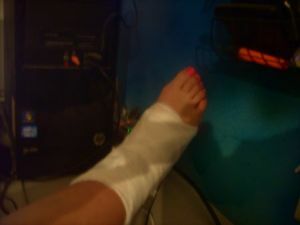
In the first case is usually treated in a conservative way. On the broken ankle, a bandage is fixed, which is fixed with a bandage.
Do not overstretch your leg, so as not to obstruct normal blood flow. Binding should be done from the top down, when reaching the fingers, turn in the opposite direction. On the injured foot impose a plaster for a month and a half.
The time in the cast is determined individually, as the time of bone splicing increases with age. After removal of gypsum, a control X-ray study is performed, on the basis of which a rehabilitation course is offered.
If the injury is combined with the displacement of the bone , it is treated conservatively only if it is possible to accurately restore the natural position of the bones.
The patient is usually given a local anesthetic and, after half an hour, refills the bones and debris into place. Then impose a cast. In some cases, with a second bias, the leg is fixed in the immobilizer.
Surgical intervention
In this case, it is extremely important to quickly deliver the victim to the doctor. The operation involves the insertion of bones and the suturing of ruptured soft tissues and vessels. Further treatment coincides with therapy with closed fracture.
In all cases, usually prescribed anti-inflammatory drugs, as well as drugs that promote bone splicing.
Rehabilitation after injury
The rehabilitation period starts with the removal of gypsum. To improve blood circulation, is prescribed for electromagnetic therapy.
Rehabilitation after an ankle fracture without bias or offset is divided into two stages:
- Immobilization( about a month);
- Functional joint restoration( from 1 to 3 months).
At the first stage of , patients are recommended therapeutic gymnastics, designed to increase muscle tone.
The second stage of focuses on exercises designed for functional recovery of mobility and muscle tone of the leg.
Preventive measures
To prevent fracture in the ankle recommend :
- No preparation not to practice traumatic sports;
- To include in its diet products rich in Ca and Group D vitamins;
- Do gymnastics;
- Avoid hypodynamia, lead an active lifestyle.

